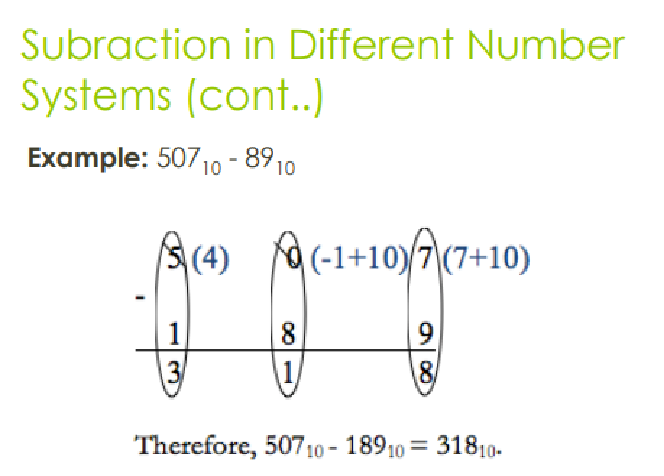COMPSCI LECTURE ( 2ND TERM)
4.8(5)
4.8(5)
Card Sorting
1/77
Earn XP
Description and Tags
Study Analytics
Name | Mastery | Learn | Test | Matching | Spaced |
|---|
No study sessions yet.
78 Terms
1
New cards
It includes a wide variety of languages used to communicate with computers.
Programming languages are a subset of _________.
Programming languages are a subset of _________.
Computer Language
2
New cards
TWO GROUPS OF COMPUTER LANGUAGE
High-level languages and Low-level languages
3
New cards
designed to be easier to use, more abstract, and more portable than low-level languages.
high-level languages
4
New cards
are machine oriented and require extensive knowledge of computer hardware and its configuration.
Low-level languages
5
New cards
The term low level means_____ to the way in which the machine has been built.
closeness
6
New cards
Low-level languages are further classified into?
Machine Language and Assembly Language.
7
New cards
is the lowest form of computer language and the only language that is directly understood by the computer.
Machine Language (also called machine code)
8
New cards
Machine language is nothing but numeric codes written as strings of _____ and _____.
0’s(zero) and 1’s(one).
9
New cards
it is the most efficient language for computers.
Machine Language
10
New cards
essentially a symbolic version of machine language.
Assembly Language
11
New cards
In Assembly language, Each operation code is given a symbolic code such as ____ and _____
ADD for addition and MUL for multiplication.
12
New cards
In assembly language each line of the program corresponds to ____instruction in machine code.
one (1)
13
New cards
programming languages that look like natural
language text (their construct is closer to human language) and are so-called
because they are independent of the particular computer.
language text (their construct is closer to human language) and are so-called
because they are independent of the particular computer.
High-level languages
14
New cards
Characteristics of High-level languages:
Codes (statements) usually resemble__________and these languages tend to be easier to learn and understand than a low-level language.
Codes (statements) usually resemble__________and these languages tend to be easier to learn and understand than a low-level language.
English sentences or mathematical expressions
15
New cards
Characteristics of High-level languages:
A single statement in a high-level language is translated into its ______.
A single statement in a high-level language is translated into its ______.
equivalent machine code instructions
16
New cards
A computer can only understand programs written in machine code.
Program Translators
17
New cards
To run a program written with a higher-level language, it has to be _____. This process is done through the use of program translators.
Translated into its machine code equivalent
18
New cards
There are _____ classifications of system software used for translating programs from a high-level to its low-level equivalent.
3
19
New cards
3 classifications of system software are used for translating programs from high-level to their low-level equivalent.
high level language ----> program translator ----> Machine code
20
New cards
It transforms high-level language-written source code into a particular computer’s machine or assembly language code.
Compiler
21
New cards
A program that is specifically used to translate assembly language source codes into machine language.
Assembler
22
New cards
An assembler takes____(assembly language
instructions) and directly converts them to ___ (operation codes/machine codes) straightforwardly.
instructions) and directly converts them to ___ (operation codes/machine codes) straightforwardly.
mnemonic codes and opcodes
23
New cards
Assembler examples include:
MASM, TASM, NASM, and FASM.
24
New cards
A program that directly executes a source code.
Interpreter
25
New cards
It reads the source code one line at a time and then executes it: no object code is produced, and so the program has to be interpreted
each time it is ran.
each time it is ran.
Interpreter
26
New cards
This is the lowest level of programming language. Instructions and data are in the form of machine language. Only binary numbers are used (zeros
and ones)
and ones)
First-Generation Programming Language
27
New cards
The _______are still considered low-level programming languages, though there is a significant improvement in terms of coding ease. Assembly language belongs to this generation.
Second-Generation Programming Language
28
New cards
High-level programming language. Instructions were written using
English-like keywords.
English-like keywords.
Third-Generation Programming Language
29
New cards
Dubbed as a very high-level programming language, fourth-generation programming languages took advantage of the computer’s multimedia processing in program development.
Fourth-Generation Programming Language
30
New cards
languages were used initially in artificial intelligence applications. It aimed at computers to solve problems with little or without intervention from the programmers.
Fifth-Generation Programming Language
31
New cards
A ____ is a fundamental style of computer
programming.
programming.
programming paradigm
32
New cards
There are four main paradigms:
Object-Oriented Programming
Imperative Programming
Functional Programming
Logic Programming
Imperative Programming
Functional Programming
Logic Programming
33
New cards
creating objects as program components.
Object-Oriented Programming
34
New cards
uses a series of terms or statements to solve a problem.
Imperative Programming
35
New cards
treats programming as the evaluation of mathematical functions.
Functional Programming
36
New cards
implements logical statements as the body of code.
Logic Programming
37
New cards
A list of instructions for carrying out a process step-by-step
Algorithm
38
New cards
Two kind of algorithm
Pseudocode
Flowchart
Flowchart
39
New cards
in pseudocode Read symbol is?

40
New cards
in pseudocode OUTPUT symbol is? (this is different from what we know from the class of sir Jan)

41
New cards
Notation Commonly Used in Flowcharting
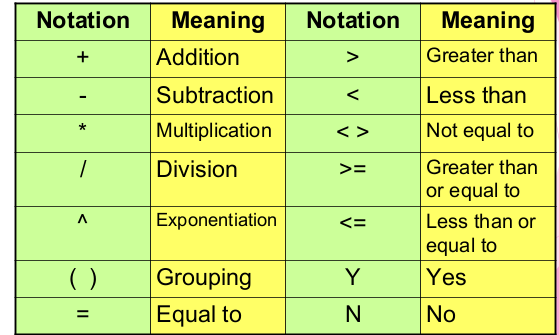
42
New cards
a software, which makes a computer to actually work. It is the software that enables all the programs we use.
Operating System
43
New cards
The OS organizes and controls the____. OS acts as an ____ between the application programs and the machine hardware.
hardware and interface
44
New cards
OPERATING SYSTEMS DOES?
Control and allocate memory
Prioritizing system requests,
Control input, and output devices,
Facilitate networking, and
Manage file systems.
Prioritizing system requests,
Control input, and output devices,
Facilitate networking, and
Manage file systems.
45
New cards
functioned without any operating system.
Single-user system(directly operates the computer)
programmer/User as operator
Paper tape or punched cards
Preparing a computer for a single user usually requires a considerable amount of time.
Single-user system(directly operates the computer)
programmer/User as operator
Paper tape or punched cards
Preparing a computer for a single user usually requires a considerable amount of time.
Early Systems - Bare Machine (the 1950s)
46
New cards
_____Operating Systems are those which Perform all the instructions in a Sequence Manner
Instructions that are given by the user will be executed by using the FIFO Manner means First in First Out.
All the Instructions that are Entered First in the System will be Executed First and the Instructions that are Entered Later Will be Executed Later.
Serial Processing
47
New cards
Reduce setup time by batching jobs with similar requirements.
Add a card reader, Hire an operator
The operator groups similar jobs together and executes them
sequentially.
A batch is entered into the computer and software called the supervisor
Need to distinguish job from job and data from the program.
Batch Processing (1960’s)
48
New cards
is a technique to execute a number of programs simultaneously by a single processor.
Multiprogramming
49
New cards
is a logical extension of multiprogramming.
Time-sharing, or multitasking,
50
New cards
In this, the CPU time is shared by different processes, so it is called
a_____.
a_____.
“Time-sharing System”
51
New cards
This type is the most popular among operating systems.
These are operating systems that are commonly installed on personal computers and notebooks.
The purpose of these operating systems is to allow users to run
word processors, spreadsheets, internet browsers, video games,
and other types of programs conveniently.
These are operating systems that are commonly installed on personal computers and notebooks.
The purpose of these operating systems is to allow users to run
word processors, spreadsheets, internet browsers, video games,
and other types of programs conveniently.
Personal Computer Operating Systems
52
New cards
A server is a computer that provides services to other
computers in a computer network.
The server can be a high-end workstation or a simple personal
computer.
A server operating system allows users to share and access
different computer resources such as printers and disk drives.
computers in a computer network.
The server can be a high-end workstation or a simple personal
computer.
A server operating system allows users to share and access
different computer resources such as printers and disk drives.
Server Operating Systems
53
New cards
These are operating systems installed on small electronic devices such as watches and mobile phones, to larger machines such as cars and airplanes.
Embedded Operating Systems
54
New cards
it handles heavy input-output operations and execute multiple jobs at the same time.
Mainframe Operating Systems
55
New cards
Compact operating systems running on smart cards.
A smart card is a card containing a tiny CPU chip for processing and data storage (thus the term ‘smart’).
Examples of smart cards include ATMs and credit cards.
A smart card is a card containing a tiny CPU chip for processing and data storage (thus the term ‘smart’).
Examples of smart cards include ATMs and credit cards.
Smart Card Operating Systems
56
New cards
The modern operating system uses two interfaces, the ____ and the ____
command-line interface (CLI) and Graphical User interface (GUI).
57
New cards
also known as the command interpreter uses a prompt for users to enter commands through the keyboard.
Command-line interface
58
New cards
An operating system implements and uses graphical symbols such as forms, menus, and cons for users to perform common computer operations.
Compared to CLI, this interface provides a much more user-friendly environment for users to work on.
Compared to CLI, this interface provides a much more user-friendly environment for users to work on.
Graphical User Interface (GUI)
59
New cards
A collection of numbers together with operations on those numbers and the properties that the operation satisfies
Number System
60
New cards
a writing system for expressing numbers using digits or symbols in a constant manner
a way to represent numbers
a way to represent numbers
Number System
61
New cards
Different numeration system used by different cultures?
Tally Number System
Babylonian Numeration System
Egyptian Number System
Babylonian Numeration System
Egyptian Number System
62
New cards
simplest number system ever used
making use of single stroke to represent objects
making use of single stroke to represent objects
Tally Number System
63
New cards
used only two symbols to represent a one and a ten
used to measure time and angles
used to measure time and angles
Babylonian Numeration System
64
New cards
uses symbols such as man, pointing-finger, fish heel bone, lotus flower, to represent numbers that are the power of ten
Egyptian Number System
65
New cards
method of counting that uses only one symbol – has the same value regardless of its position
Non-positional Number System
66
New cards
symbols have different values depending on their position in the number
values are determined through: the digit itself, the position of the digit in the number, the base of the number system
Positional Number System
67
New cards
determines how many times a digit will be multiplied by itself on its position
radix point (decimal point) divides the whole numbers from fractional numbers
Power
68
New cards
Number System Commonly Used in the Field of Computing
Decimal System (base 10)
Binary System (base 2)
Octal System (base 8)
Hexadecimal System (base 16)
Binary System (base 2)
Octal System (base 8)
Hexadecimal System (base 16)
69
New cards
Defines the number of symbols used in the number system
Base 10 (Decimal) – 0, 1, 2, 3, 4, 5, 6, 7, 8, 9
Base 2 (Binary) – 0,
Indicated by a subscript .
Base 10 (Decimal) – 0, 1, 2, 3, 4, 5, 6, 7, 8, 9
Base 2 (Binary) – 0,
Indicated by a subscript .
Radix or Base
70
New cards
The digit that has the greatest effect on the value of the number
Most Significant Digit (MSD)
71
New cards
The digit that has the least effect on the value of the number
Least Significant Digit (LSD)
72
New cards
Commonly Used Number Systems in Computing
Decimal (N10)
Binary (N2 )
Octal (N8 )
Hexadecimal (N16)
Binary (N2 )
Octal (N8 )
Hexadecimal (N16)
73
New cards
how to compute for
Non-Decimal to Decimal (n2,n8,n16 ---> n10)
Non-Decimal to Decimal (n2,n8,n16 ---> n10)
multiply the given by its base
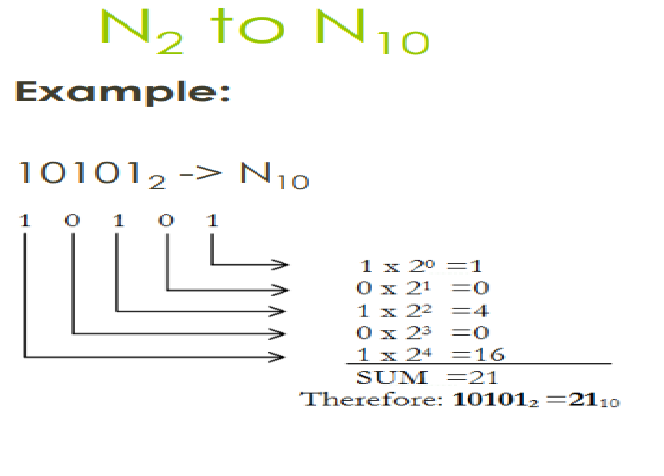
74
New cards
how to compute
Decimal To Non-Decimal (n10 --->n12)
Decimal To Non-Decimal (n10 --->n12)
divide the given from its base and the remainder is the answer
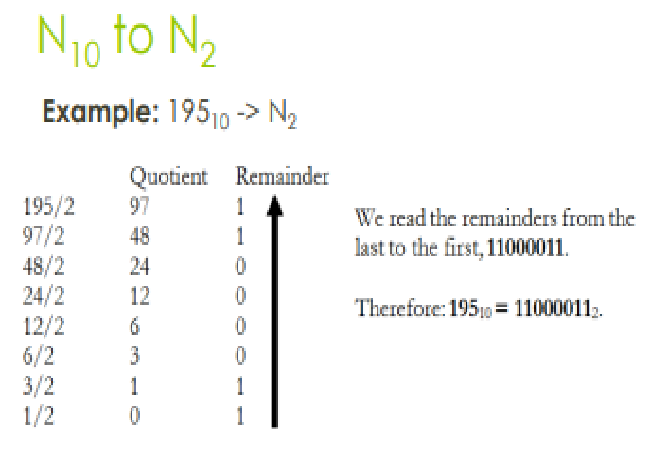
75
New cards
Other Conversions ( n2
group the binary from groups containing a 3 numbers per groups and add the binary who has value in its 2nd power equivalent
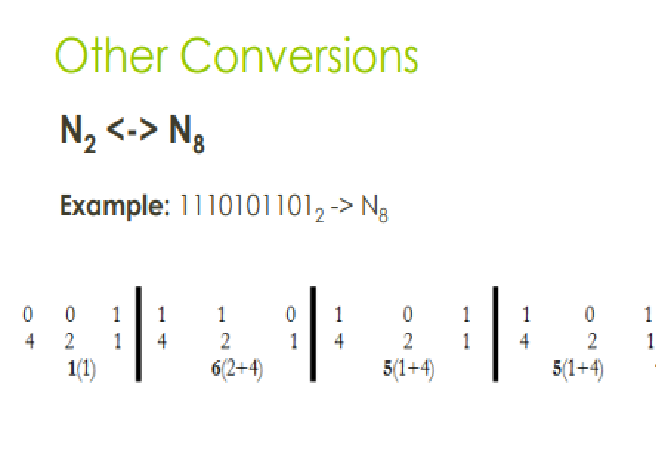
76
New cards
Non-Decimal to Another NonDecimal Base ( n8--->n10)
since there is no direct conversion from ocatl to hexa.
you will need first to convert the octal to binary and conver the binary to hexa
you will need first to convert the octal to binary and conver the binary to hexa
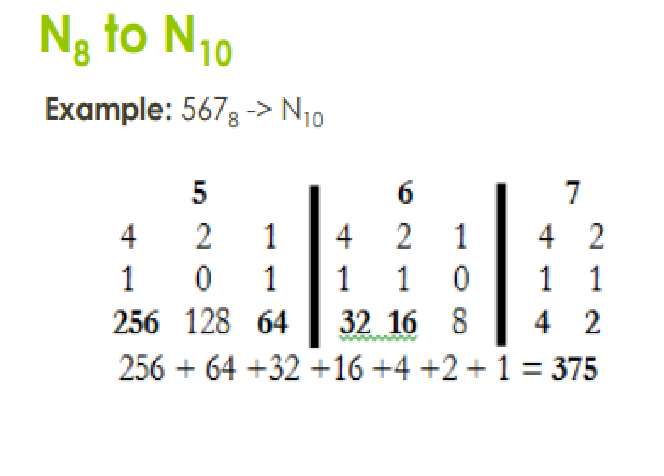
77
New cards
Addition in Different Number Systems
The addition of numbers (in any base) follows a common rule. We just take note of the base of the numbers being added. We take for example the addition of decimal numbers (base 10) 563 and 347. Observe that if the sum of the digits is greater than or equal to the base of the numbers, we subtract the base from the sum and a carry is produced.
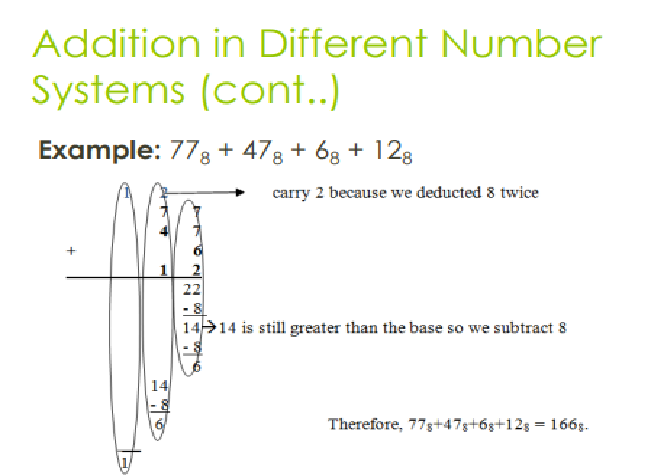
78
New cards
Subtraction in Different Number Systems
Rule: The base of the number system is important in subtraction. When we borrow, we subtract 1 from the preceeding digit but we add the value of the base to the borrowing digit.
